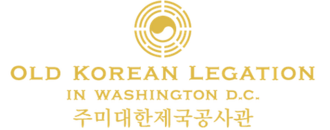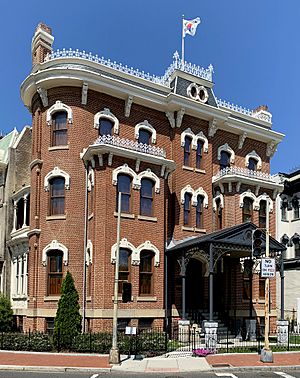Old Korean Legation Museum facts for kids
Quick facts for kids Old Korean Legation Museum |
|
|---|---|
 |
|

Old Korean Legation Museum in 2022
|
|
| General information | |
| Architectural style | Victorian |
| Location | 15 Logan Circle NW (1500 13th Street NW) Washington, D.C., U.S. |
| Coordinates | 38°54′37.3″N 77°1′47.4″W / 38.910361°N 77.029833°W |
| Completed | 1877 |
| Design and construction | |
| Architect | Thomas M. Plowman |
| Designations | |
|
Invalid designation
|
|
| Designated: | July 25, 2024 |
| Designated: | September 9, 2024 |
| Reference #: | 100010773 |
|
U.S. Historic district
Contributing property |
|
| Designated: | June 30, 1972 |
| Part of: | Logan Circle Historic District |
| Reference #: | 72001426 |
|
U.S. Historic district
Contributing property |
|
| Designated: | November 9, 1994 |
| Part of: | Greater Fourteenth Street Historic District |
| Reference #: | 94000992 |
| Old Korean Legation | |
| Hangul |
주미대한제국공사관
|
|---|---|
| Hanja |
駐美大韓帝國公使館
|
| Revised Romanization | Ju Mi Daehan Jeguk Gongsagwan |
| McCune–Reischauer | Chu Mi Taehan Cheguk Kongsaggwan |
| lit. Korean Imperial Legation in America | |
The Old Korean Legation Museum (Korean: 주미대한제국공사관) is a historic house museum in Washington, D.C.. It's located in the Logan Circle neighborhood. This special building was once the official home for Korean diplomats in the United States.
Built in 1877, it first served as a private home. From 1889 to 1905, it became the "legation" (a type of embassy) for the Joseon kingdom and later the Korean Empire. This was a time when Korea was trying to build relationships with other countries. However, Japan took control of Korea's government in 1905, and the legation had to close.
Many Koreans saw the building as a sad reminder of their country losing its independence. After many years, the South Korean government bought the property back in 2012. It was then carefully restored and opened as a museum in 2018. The museum shows what the building looked like in the late 1800s. It has a library, a banquet hall, and a small garden. The building is an important part of Washington, D.C.'s history and was added to the National Register of Historic Places in 2024.
Contents
A Special Building with a Big Story
The House's First Owner
The story of this building began on December 16, 1877. A man named Seth Ledyard Phelps got permission to build a large, seven-bedroom house. He was a military officer who served in the Navy during the Mexican–American War and Civil War. Later, he became a diplomat to Peru.
The house was designed by Thomas M. Plowman and built by Joseph Williams. It cost $5,500, which was a lot of money back then. The home was made of brick and had a tin roof, fancy railings, and a cast metal porch. Phelps was also a real estate developer, meaning he bought and sold land and built houses. His home was one of the first big houses in the Logan Circle area. After he passed away in 1885, his wife, Lizzie, lived there for a few more years.
Korea's Diplomatic Home
In 1888, Park Chung Yang became the first Korean diplomat to the United States. This was a big step for Korea, as it was trying to make friends with Western countries. At first, Korea's first legation opened on O Street NW.
At that time, China had a lot of power over Korea. China didn't want Korea to have its own diplomatic offices in Western countries. But the United States disagreed with China, so Korea was allowed to open its legation. China still tried to interfere, telling Korean diplomats not to meet with others. But the Koreans didn't listen.
In February 1889, the Korean government moved its legation to Phelps's old house at 15 Iowa Circle. In 1891, the Korean government bought the building for $25,000. King Gojong spent this large sum to strengthen ties with the U.S. In 1898, a small fire broke out on the third floor but was put out with help from neighbors.
However, things changed for Korea. In 1905, the Empire of Japan took control of the Korean Empire. This meant Korea lost its ability to conduct its own diplomacy. The building on Logan Circle was no longer a legation. In 1906, the Korean diplomat made a farewell visit to the U.S. State Department. The U.S. then handled Korean affairs through the Japanese legation.
In 1910, Japan officially annexed Korea. The building was then bought by the Japanese government for just $5. Soon after, it was resold to an American for only $10. This was seen as a great insult and a sad moment for Koreans.
A Long Journey Home
Over the next few decades, the building had many different uses. It was a private home, a recreation center for African Americans in the 1940s, and even a union hall. After Korea became free again after World War II, many Koreans wanted to buy the house back.
Timothy and Lauretta Jenkins bought the home in 1977. They knew the house had some history but didn't fully understand its importance to Koreans. They often had Koreans visit, asking if they would sell the house. The Jenkins were not interested in selling.
One day in the 1980s, they met a man who was the grandson of Korea's first diplomat to the U.S. He walked through the house with great respect. This made the Jenkins realize how much the building meant to Koreans. They still didn't want to sell, worrying it might not be preserved properly.
In 2008, officials from the South Korean embassy began talking with the Jenkins. The couple initially wanted $6 million for the property. In 2009, the South Korean government set aside money to buy the house. Finally, in 2012, the South Korean government's Cultural Heritage Administration (CHA) bought the property for $3.5 million.
For many South Koreans, getting the building back was a huge victory. It was seen as restoring national pride that had been lost. Kim Jong-gyu, a leader of a cultural heritage group, said it was "not just a purchase of a building, but a restoration of our national pride." This purchase happened during a time of some disagreements between Japan and South Korea over historical issues from World War II.
The Museum Today
After buying the building, South Korean officials announced it would become a cultural center. They wanted it to help Americans learn about Korean culture and teach Koreans about their history. In 2013, the building was included in Logan Circle's heritage trail, with a sign explaining its history.
From 2015 to 2018, the building was carefully renovated. It was restored to look like it did in the late 1800s. The outside kept its original Victorian style. The inside mixed these old details with Korean decorations. Each room was named as it was when it was a legation. Old furniture was bought, and the wallpaper and carpets were chosen to match the time period. A small parking lot was turned into a beautiful garden with a granite "Eternal Youth Gate." The museum now has a library, a photo exhibit, the minister's bedroom, and a banquet area.
On May 22, 2018, the South Korean flag was raised above the building, and the Old Korean Legation Museum officially opened. The opening ceremony happened when President Moon Jae-in visited Washington, D.C. The museum is open Tuesday through Sunday from 10:00 AM to 5:00 PM, and admission is free.
In 2020, to mark 70 years since the U.S. military entered the Korean War, a banner was displayed outside the museum. It included messages of peace and thanks to the U.S.A. In 2023, Korean First Lady Kim Keon-hee visited the museum during a trip to Washington, D.C.
The building was recognized as a historic site in Washington, D.C., in July 2024. It was also added to the National Register of Historic Places in September 2024.
Want to Learn More?
- List of museums in Washington, D.C.
- Koreans in Washington, D.C.
- National Register of Historic Places listings in Washington, D.C.
- South Korea–United States relations

